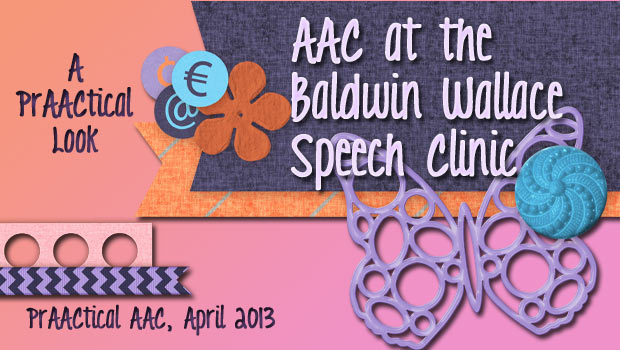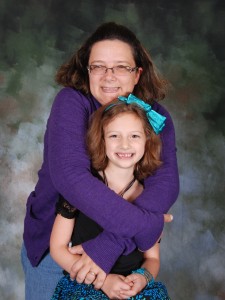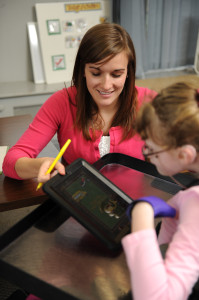A PrAACtical Look: AAC at the Baldwin Wallace Speech Clinic

We’re always curious to know how other SLPs are running their AAC programs. When we got the idea for a series of posts highlighting schools and clinics that embrace AAC, we got excited. Welcome to “A PrAACtical Look”! In this series, we hope to introduce you to AAC programs around the world and give you a peek into what goes on in those practices. Hopefully, it will help strengthen connections in the AAC SLP community as we all get to know more about the ways in which our colleagues approach AAC assessment and intervention. There are many of you out there doing fine work with children and adults who use AAC. If you’d like to tell us about your AAC program, contact us through the blog or our Facebook page.
We couldn’t be happier to start this series by introducing you to a place where undergraduate SLP students get hands-on experiences in AAC. Any program that gets young professionals excited about AAC gets a big thumbs up from us! Please join us in peeking into the clinic at Baldwin Wallace University in Berea, Ohio (USA).
 I am Christie Needham and currently work at Baldwin Wallace University. My current title is Assistant Professor but I also have the responsibility of being Clinic Director at the Baldwin Wallace Speech Clinic. Our clinic is unique in that we are an undergraduate only program in Communication Disorders, so undergraduate clinicians only staff our clinic. In addition our program provides our students with the unique opportunity to work with children with complex communication needs. What better way to brainstorm technology then with young students who “get it”!
I am Christie Needham and currently work at Baldwin Wallace University. My current title is Assistant Professor but I also have the responsibility of being Clinic Director at the Baldwin Wallace Speech Clinic. Our clinic is unique in that we are an undergraduate only program in Communication Disorders, so undergraduate clinicians only staff our clinic. In addition our program provides our students with the unique opportunity to work with children with complex communication needs. What better way to brainstorm technology then with young students who “get it”!
Several years ago I was approached by a group of parents looking for a “speech camp” over the summer. The problem was that their children were functionally nonverbal with complex behavior and communication needs. The families were looking for intensive therapy and in northeast Ohio there was not such a camp. So we took a risk and started the first Intensive Intervention Program for Nonverbal Children. Over the years this camp has provided some amazing research and therapeutic opportunities.
Our first obstacle was to create a diagnostic tool that worked to help capture the sometimes small but significant changes our children make. This tool has then been used to gather lots of research data on the efficacy of treatment. And the good news is it works! So how do you do it? Well keep reading …
Our program is structured with up to 6 clients and 3 undergraduate students. These students receive training on behavior modification strategies, AAC strategies and literacy skills with AAC. Each client receives an evaluation to determine baseline skills. Then the planning begins.
I love themes! So what better way to establish themes then to work with books. We focus each week of camp around a single book. Each child receives his/her own copy of the book that is adapted with pictures to facilitate communication between the client and caregiver as well as literacy. Activities are then planned expanding on the vocabulary in the book.
client and caregiver as well as literacy. Activities are then planned expanding on the vocabulary in the book.
But as we all know vocabulary is not all created equal. The focus of our camp is functional communication, so as I like to enforce to my students, “leave the nouns at home”. While nouns are necessary, farm and zoo animals have a limited focus in comparison to action verbs and feelings.
Then we develop a “schedule”. Every client participates in an opening large group activity. We incorporate music, movement, and greetings into the opening. After that clients are split up into either small group or individual sessions. Individual sessions focus on specific goals developed by both family and student clinicians. These sessions last 10-15 minutes at most. Small group activities focus on reinforcing vocabulary through motivating activities such as crafts, sensory activities, games and appropriate play activities. At all times a variety of communication methods are available for the clients to allow for exploration. Snack time and closing group are the last large group activities. These allow for opportunities to encourage social communication and a final “game” with all the clients before saying goodbye. All of this occurs in a two-hour period three days a week.
One of the other benefits of this kind of group are the relationships formed between the families. Support networks are necessary and this situation has brought together families to help support each other in their journeys.
I hope this has provided you with one way to look at a group environment for some of our complex clients. I can be reached at cneedham@bw.edu or 440-826-2070.
Filed under: PrAACtical Thinking
Tagged With: AAC services, Christie Needham, clinic, PrAACtical Look
This post was written by Carole Zangari
